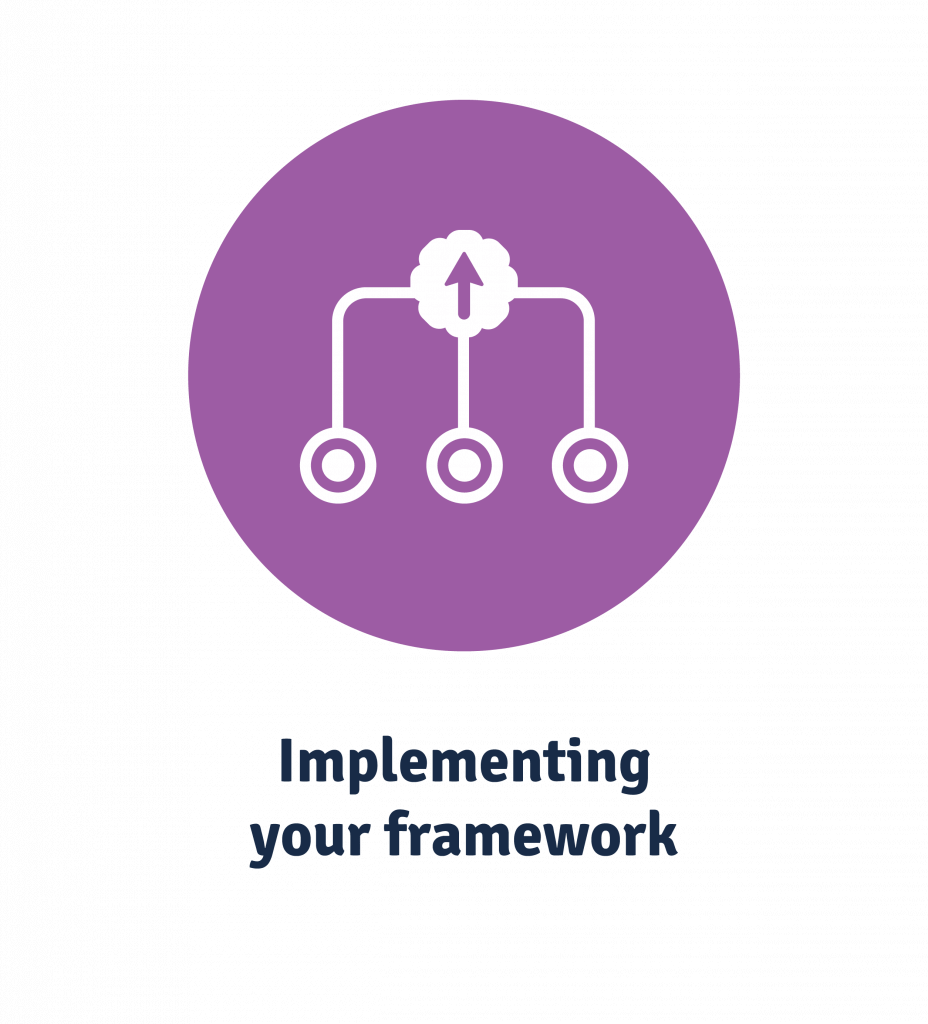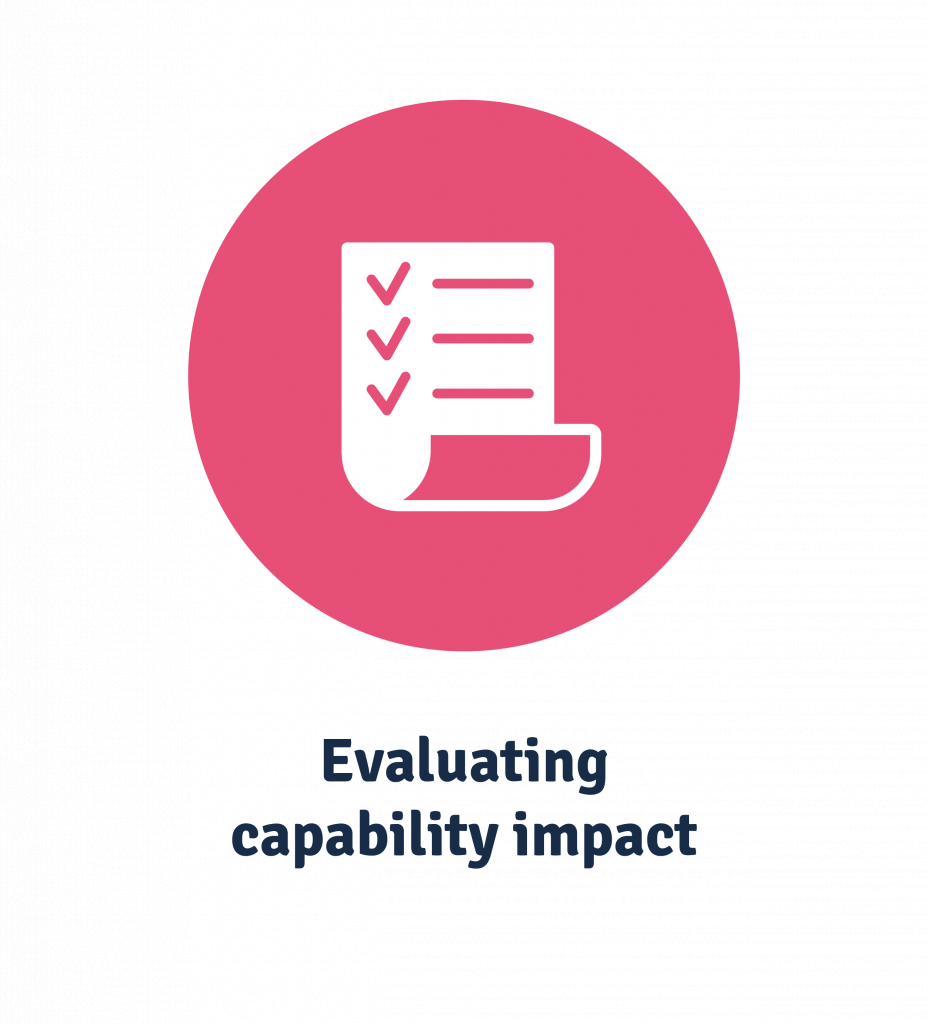How to Establish a Successful Workforce Capability Framework Within Your Organisation
You’ve gone to all the effort of creating a highly personalised workforce capability framework that is backed by external and internal environmental insights. But then it’s left to dust as another unadopted relic of enterprise.
So, how do you avoid the business waste heap? Establishing a successful capability framework requires some key milestones before, during and after implementation. In this guide, we’ll walk you through the key drivers of successful capability use.
What is a workforce capability framework?
A workforce’s capability framework defines the common processes relating to workforce development that support an organisation’s purpose. Most capability frameworks are written to describe the behaviours, skills and knowledge expected of employees in both their day-to-day work and specific job roles.
How do you implement a workforce capability framework?
Successfully implementing a workforce capability framework into your organisation need not be painful, but it does need a plan. Let’s walk through the three stages of establishing and embedding a framework into your culture and workforce management.
- Preparation and planning
- Implementation
- Maintenance.
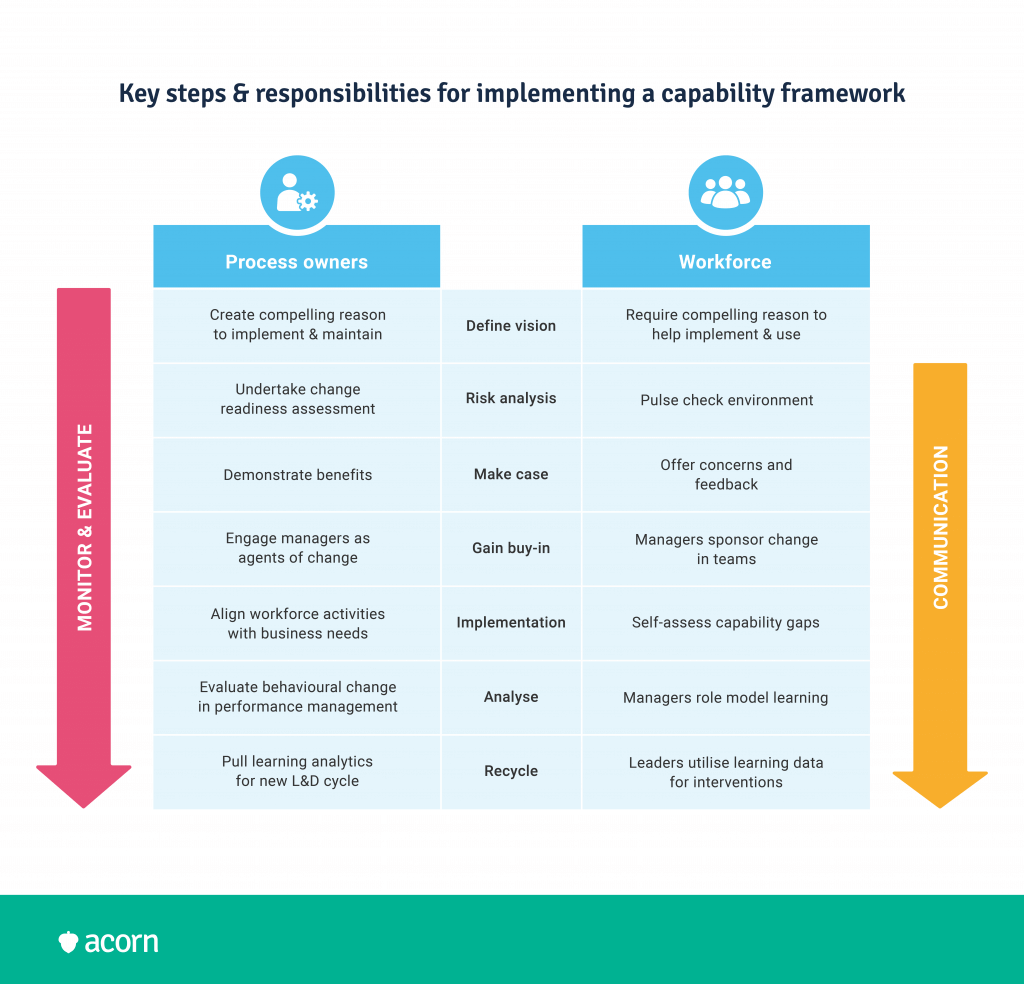
Before: Building your capability framework
Before you begin to roll out capability use cases, you’ll want to put a change management plan in place. There’ll be stakeholder expectations, employee sentiment and potential resourcing challenges to manage. This means you need to focus on outlining:
- Project owners
- Purpose and vision
- Communication strategy
- The capabilities you need to address in the immediate future.
Define process owners
Defining roles, responsibilities and ownership can be difficult. Process owners need to volunteer time for end-to-end activities involved in not only capability development, but maintenance of a framework. Your owners will need to manage process maturity and its impact on alignment with business processes, too.
Nevertheless, you want process owners because this is a people-focused transformation. They’ll be responsible for:
- Process mission and purpose
- KPIs and process health reports
- Stakeholder engagement
- Maturity of investments and sponsorships.
HR is a good place to draw owners from, but you’ll want a cross-functional team to define and structure capabilities. Business architects, functional specialists or heads of departments, and product owners (specifically for tech capabilities) are all good mines to drill. These are the roles best positioned to accurately outline your value chains and streams. (And this is key for building consensus amongst any senior executives or key stakeholders at an early stage.)
Key traits you’ll be looking for in potential owners include:
- Subject matter expert
- Affected by poor processes/will gain from an improved outcome
- Can positively influence others
- Aptitude for process thinking and improvement
- Able to pull and analyse key metrics.
Outline the purpose
To define your vision and purpose, you need to think about what your framework is being used for and how. We’d like to posit operational performance in the name of business success.
What’s not always common in private enterprise but seen often in public sector frameworks is how a capability framework can be a blueprint for optimal job performance. Look at national disability services. The disability sector must strongly align their organisational objectives with performance indicators to support the diversity of people impacted by family and community services. The NDIS workforce capability framework and disability career planner defines “what good looks like”.
Effective performance (and performance management) matters because it provides early warning signs of problems that could affect business direction. This is because performance is, in a way, insidious. Bad performance will ripple through organisational culture (e.g., coworkers resenting someone not pulling their weight), processes (bottlenecks) and outcomes (project or service delays).
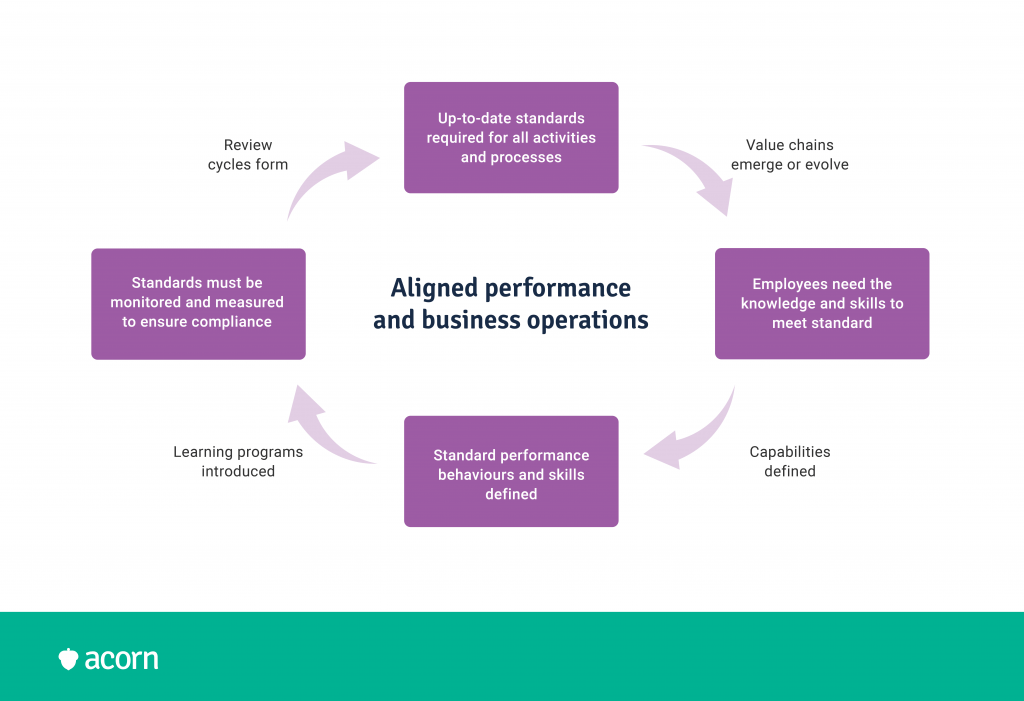
Defining performance in terms of business impacts is the simplest way to:
- Uncover the capabilities required to achieve business goals and future needs.
- Clearly outline the purpose of the framework, and therefore the crux of your communications plan.
Market to employees
Unlike other models in the enterprise toolkit, a capability framework needs buy-in from all business levels to be successful and sustainable. The most influential factor in managing a change initiative is how honest and open leaders are from the outset. Ergo, successful adoption comes from offering up a transparent framework.
Firstly, let your people know what’s happening and why. Part of creating a communications plan is connecting high-level organisational changes to the day-to-day.
For example, it could be that role descriptions are going to change. Some employees may fear responsibilities being taken away or added, especially in major job roles. Explaining the need for new descriptions—say, better L&D goal setting and more efficient recruitment—before changes are implemented means employees can acclimate in advance. This creates a shared vision, and shared vision allows for shared ownership. (All of which can enhance organisational culture.)
Utilise supporting resources to help unpack capability language. The NSW Government has user guides for managers and employees to apply their framework to recruitment, onboarding, self-assessment and professional development. The Queensland Family and Child Commission’s framework comes with an entire guide on how to read, interpret and apply capabilities across use cases.
Other options include:
- Self-assessments used by an individual to ascertain their own proficiency in demonstrated capabilities.
- L&D assessments for reviewing development needs. Can be used by an individual and/or manager.
- A job description builder for your HR and recruitment staff. Understanding how to put together a description can be invaluable to the hiring process.
Pick a lane
Harsh heading, but hear us out. It’s useful to decide now if you’re rolling out organisation-wide changes or if you’ll work through departments, as well as what capabilities you’re focusing on. Trying to be good at too many things, or indeed, trying to suddenly change too many things at once could leave you falling flat on key capabilities.
Your core capabilities often have high fixed costs, which gives even more weight to a proactive planning approach. Say you’ve designed a framework with 16 capabilities. It’s tempting to want to enact them all at once, but you may invest resources where they’re not needed.
Prioritising capabilities can be done by assessing their risk against their future importance. For example, if a capability has an immediate impact but is currently performed above a pre-determined average, it would be considered mature and therefore not in need of attention.
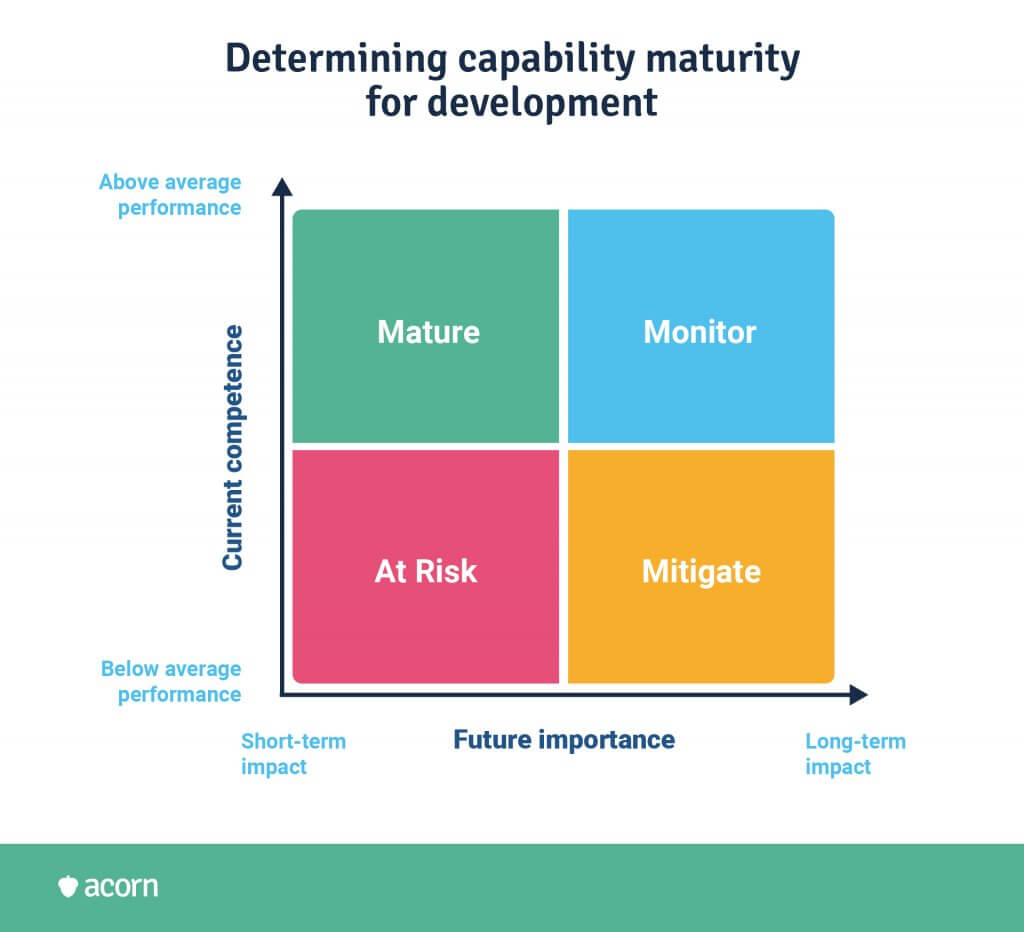
You can determine your own parameters for “risk”, but we commonly see the following used:
- Poor utilisation
- Lack of resources
- Business value.
During: Implementation
Off the back of your defined purpose, there’ll likely be a few ways you utilise a capability framework. We’re going to look at the big two:
- Training and development
- Workforce planning (WFP).
Training & development
If we refer back to the cycle of aligning employee performance and business, we know that L&D is a key spoke that keeps the wheel moving. Without training and development, we lose the necessary skills and knowledge that support value chains, and in turn, the business itself.
Josh Bersin believes we are (or should be) heading towards a training approach structured almost solely by capabilities. This keeps learning dynamic and reflective of ever-changing environments.

Say you’ve got a leadership tranche of capabilities. This is a more latent skill not often taught in formal tertiary education—that’d be the technical skills that make up the brunt of job qualifications.
Yet it’s not a skillset that can be taught solely online, because your leadership style likely utilises people management strategies unique to your culture. Nor is it training you necessarily want employees to stumble into, largely because you want it to be a sustainable learning pathway so that it can be a sustainable capability within your business.
And therein lies what should be the undercurrent of your L&D efforts: Sustainability. McKinsey recommends making capability-led training a co-owned process between human resource professionals and department or team leaders, to effectively align program design and evaluation with business needs.
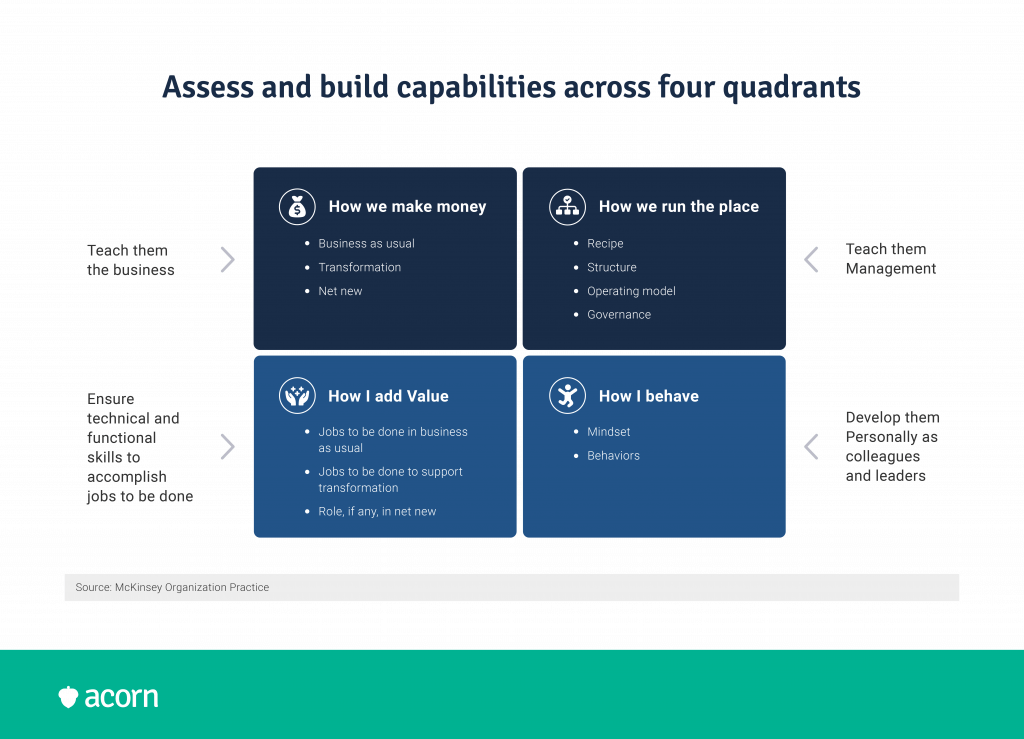
Managers can guide professional development opportunities to ensure they are timely, relevant and addressing a need or risk, while L&D leaders architect these needs into skill development programs. It also means:
- You’re measuring impact the best way (more in this in just a bit).
- Content can be created internally and strategically sourced from third parties where suitable, focusing resources.
- Development is based on impactful capabilities, not just desired skills—and therefore a continual growth strategy, not just a goal setting one.
- Collaborative learning experiences emerge over siloed pathways.
Workforce planning
Supporting performance is one piece of both the capability and WFP puzzles. In essence, capabilities support your future workforce plans because they are the building blocks that ensure your employees can deliver on your mission.
If we follow on from the example of redesigning role descriptions, implementation of capabilities could also mean restructuring jobs. A capability analysis may uncover gaps in current job families or team structures. Or perhaps your recruitment strategy is reworked with new job descriptions, or a capability database is created to better create crisis teams or support internal mobility. It might even be that you better understand capacity purely based on the functional capabilities you currently possess compared to the ones you need.
Rooting this in workforce analytics is crucial for informed decision making and validating those decisions to executives. Since workforce decisions involve broader considerations than just the workforce, know what data you have and how you can exploit reduces the risk of any ripple effects.
After: Monitoring impact
Consider this the accountability phase of capability implementation.
Workforce capability isn’t the end goal, after all. Improved business performance is. So, how can you be sure you’re consistently obtaining high performance?
Here are a few ways you can evaluate the impact of capabilities in your organisation.
- Job performance
- Cross-team collaboration
- Utilisation of data.
Employee performance
This is the truest test of capability, in all meanings of the word. Any of the goals you set for a framework should be observable in one way or another.
At the highest level, look to the tools you use to evaluate performance. Can you see the links to business strategy in a job score card? How often are performance indicators being assessed? What ways do you reinforce skills application? Are employees rewarded for improved performance? Do performance KPIs reflect capabilities?
It’s also important to repeatedly assess support for capability development. We’re not talking about the general (though still useful) benchmarks for L&D, like LMS completion rates. There should be bigger objectives related to behavioural changes.
These results may seem invisible or intangible, but there are markers for understanding intentional learning behaviours and acting on capability requirements.
- Do employees plan for the future by goal setting, researching and self-assessing?
- Are they sharing with and learning from their peers, through debate, conversation and ideation?
- Do they reflect on feedback and self-initiate change?
- Do they experiment in the face of challenges and risks?
- Do they proactively adapt new observable behaviours to reflect changing environments?
- Are they voluntarily up to date on job and industry-related knowledge?
- Do they confidently apply new capabilities?
As an aside, McKinsey found that most organisations struggle to make the impact they want, in no small part down to leadership not role modelling learning for others. It pays to evaluate how executives and managers apply training, if they undertake it at all.
Cross-function collaboration
If a capability framework starts with collaboration, it tracks you can continue to measure work across boundaries. You’ve restructured teams, even created new ones that pull different experts in. The Harvard Business Review found sharing services saves 15 to 20% of administrative costs, without losing quality of output. Cross-functional teams also help bring focus to business areas so that they can put their efforts into things only their team can do.
Shared brand identity is something to assess here. Competing opinions come with the cross-functional territory, but what matters is a coherent understanding of your organisation’s mission. Remember that siloed knowledge works in no one’s favour.
Consider then the breakup value of each of your units; are you worth more apart than together? If so, your implementation may not have worked as you hoped, and you’ll likely find that unique capability value is worth more than combined.
Data utilisation
You’re gathering data throughout this whole process. While you may be analysing it, can you be sure you’re leveraging it in a way that supports capability management as much as business?
Gartner found just 12% of organisations use their talent data effectively in business decisions. (12%!) Particularly if you’ve piloted a program on a test cohort, you’ll want a solid methodology to prove any assumptions and justify investments.
The following are good tenets to follow to ensure you’re recycling capability data effectively.
- The entire organisation must value data collected from implementation. This goes back to creating a communications plan.
- Data cannot be siloed. What’s learned about workforce capability should be shared with L&D, team managers and so forth. Put it in the hands of people who need it and can affect change with it.
- Data needs to be timely. No use saving information on capability gaps for the annual meeting in three months; raise issues in real time so they can’t fester.
- Make it visual. This means it’s more easily digested and shared, and decisions can be made faster.
Conclusion
Like the framework they’re housed in, capabilities need a structure to be effectively implemented and actioned.
It starts when you’re designing your framework by defining process owners, the purpose of the project, a change management plan and a focus for implementation. From there, you’ll want to incorporate capabilities into key business activities, like employee training and strategic WFP.
When you’re up and running, it becomes about monitoring employees for positive changes in performance. Keep an eye on how capabilities are shared between and for other teams, and make sure you’re effectively using any data you’re collecting along the way.
Related Reads on This Topic

How to Develop a Capability Building Framework
Building capability is a beast, but it can be tamed with a framework for business success.

Building Mission-Critical Knowledge in the Workplace
You have to give your employees the tools and mentors they need to drive business success.

Is Tailored Training Really that Effective in the Workforce?
It’s kind of the basis for building a workforce that can weather economic storms.


